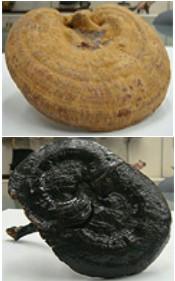Ganoderma
- Name
- Origin
- Where Does It Grow?
- Nature and Flavor
- Identified Active Components / Major Chemical Constituents
- Drug Actions in TCM
- Traditional Uses in TCM
- Pharmacological Actions
- Toxicology
- Administration and Dosage
- Adverse Effect, Side Effects and Cautions
- References
Name
Latin Name: Ganoderma
Common Name: Ganoderma / lucid ganoderma / reishi mushroom

Scientific Name: Ganoderma lucidum (Leyss. Ex Fr.) Karst / Ganoderma japonicum (Fr.) Lloyd
Chinese Name: 靈芝
Pinyin Name: : ling zhi
Origin
Fruiting body of Ganoderma lucidum (Leyss. Ex Fr.) Karst or Ganoderma japonicum (Fr.) Lloyd, family Polyporaceae.1 The mycelium and spore of Ganoderma are also applied nowadays.
Where Does It Grow?
In nature, ganoderma is mainly disturbed in temperate and subtropical zones. The fungal plant grows on dead or dying eastern hemlock or areas that are lack of sunshine, fertile and high humidity. Nowadays, the supply is mainly sourced from cultivation, mainly from Jiangxi and Zhejiang and other provinces of China.1
Nature and Flavor
Ganoderma is sweet in flavor, neutral in nature, and manifests its therapeutic actions in the heart, lung, spleen and kidney meridians.2
Identified Active Components / Major Chemical Constituents
Major chemical compounds in ganoderma include ergosterol 0.3-0.4%, fungal lysozyme and acidic proteases. The water extracts contain water-soluble proteins, amino acids, peptides, alkaloids, polysaccharides, triterpenoids mainly ganoderic acid, lucidemic acid and ganolucidic acid, etc. 1Drug Actions in TCM
Ganoderma nourishes heart, calms spirit, enriches qi (vital energy) and blood, relieves cough or breathing difficulty, and enhancs body functioning.1Traditional Uses in TCM
- Heart dysfunction causing restless spirit will have signs like insomnia, forgetfulness and fatigue. The condition can be relieved by ganoderma combined with angelica root, sour jujube seed and longan aril.
- Spleen deficiency leading to poor appetite and fatigue can be relieved by ganoderma combined with pilose asiabell root, largehead atractylodes rhizome and astragalus root.
- Lung deficiency leading to cough and breath shortness can be relieved by ganoderma combined with cordyceps and tokay.
- Ganoderma used alone promotes the production of blood and qi, which is benefit for signs like indigestion, poor appetite, fatigue, loose bowels, dizziness and soreness in the lumbar.
Modern TCM often uses ganoderma to promote recovery in chronic conditions and cancer patients, and also as immune booster.
Pharmacological Actions
Clinical study
2. Hepatoprotective Activity
In-vivo study
Aminal study
4. Immuno-stimulation
In-vitro study
Animal study
5. Anti-tumor
Animal study
Animal Study
6. Reversal of Multi-drug Resistant in Tumor Cells
In-vitro study
7. Inhibitory activity against HIV-1 protease
In-vitro study
Toxicology
Hot water extraction of Ganoderma lucidum (Fraction A) and its dialyzed and freeze-dried extract, a polysaccharide fraction (Fraction B) were examined for acute and sub-acute toxicity. In the acute toxicity tests of Fraction A and Fraction B on mice, both agents did not show any serious and lethal effects. The results showed that 50% lethal doses were higher than 5,000 mg/kg. The experiments of oral administration of Fr. A (5,000 mg/kg) to mice for 30 days showed that there were no changes in body weight, hematological features and organ weight.12
Administration and Dosage
For decoction, ganoderma is used in 6~15 grams, and can upto 30g if necessary. It is also consumed in powder or pills.3
Adverse Effect, Side Effects and Cautions
Ganoderma is not suitable for those with immune globulin hyperactivity.
References
- 李家實主編《中藥鑒定學》上海科技出版社, 2000.
- 國家中醫藥管理局編纂《中華本草》上海科技出版社1999.
- Chen J.K. and Chen T.T. Chinese Medical Herbology and Pharmacology. Art of Medicine Press 2001.
- Li E.K., Tomlinson B., et al. Safety and efficacy of Ganoderma lucidum (Lingzhi) and San Miao San supplementation in patients with rheumatoid arthritis: a double-blind, randomized, placeno-controlled pilot trial. Arthritis and Rheumatism 57: 1143-1150 (2007).
- Shi Y., Zhang S., et al. Hepatoprotective effects of Ganoderma lucidum peptides against D-galactosamine-induced liver injury in mice. J. Ethnopharmacol. 3: 415-419 (2008).
- Yang X.J., Wu Z.H., et al. In vitro and in vivo protective effects of proteoglycan isolated from mycelia of Ganoderma lucidum on carbon tetrachloride-induced liver injury. World J. Gastroenterology 12: 1379-1385 (2006)
- Chan W.K., Chan G..C., et al. Ganoderma Lucidum polysaccharides can induce human monocytic leukemia cells into dendritic cells with immuno-stimulatory function. J. Hematol Oncol. 1: 9-20 (2008).
- Nonaka Y., Abe S., et al. Effects of the antlered form of Ganoderma lucidum on tumor growth and metastasis in cyclophosphamide-treated mice. Biosci. Biotechnol. Biochem. 72: 1399-1408 (2008).
- Li Y.B., Li X.J., et al. Serum amyloid A medicates the inhibitory effect Ganoderma lucidum polysaccharides on tumor cell adhesion to endothelial cells. Oncol Rep. 20: 549-556 (2008).
- Li W., LIN Z., et al. Reversal effect of Ganoderma lucidum polysaccharide on multidrug resistance in K562/ADM cell line. Acta Pharmacologica Sinica, 20: 620-627 (2008).
- Min B.S., Hattori M., et al. Triterpenes from the spores of Ganoderma lucidum and their inhibitory activity against HIV-1 protease. Chemical & Pharmaceutical Bulletin. 46: 1607-1612 (1998).
- Kim M.J., Kim B.K., et al. Studies on safety of Ganoderma lucidum. Korean Journal of Mycology, 14: 49 – 60 (1986).


